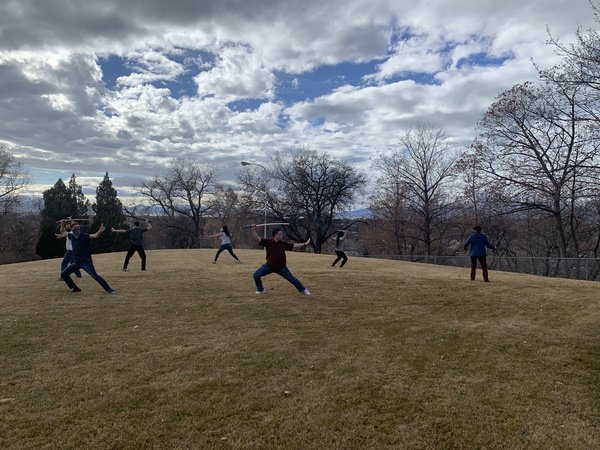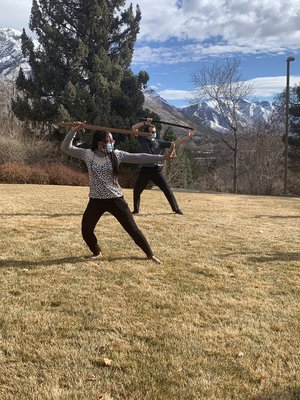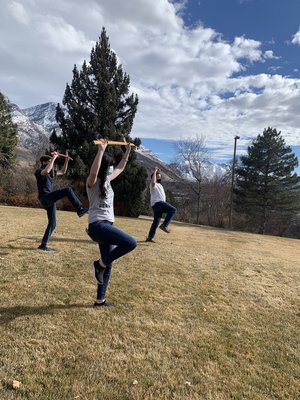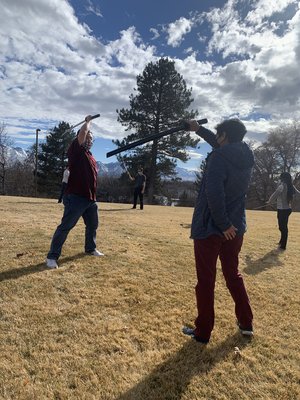Samurai, Swords, and Scientists
Feb. 19, 2021

Look out, BYU — there’s a new club on campus and they’ve got swords.
Scientists with Sword Skills (SwiSS) is exactly what it sounds like: a group of scientists (all members are currently from the Department of Chemistry & Biochemistry) with swords and the skills to use them… skills honed under the watchful eye of the club advisor, department postdoctoral fellow Dr. Richard Carson.
“The genesis of all this occurred when I was a graduate student in the JC Price lab here at BYU,” said Carson. “A friend of mine, Dr. Bradley Naylor, had completed his PhD defense and was graduating. For a graduation present, I gave him a nice wooden bokken [training sword] complete with a silk sword bag, which was my humorous little way of acknowledging his habit of idly swinging meter sticks [and] metal rods… when he would walk around in the lab and the office.”
Carson’s path as a martial artist began in childhood, meandered in and out of various styles in college, and finally arrived at Shaolin kempo in graduate school. Shaolin kempo is a blend of many martial arts disciplines, including karate, kung-fu, judo, and more. Weapons are an optional area of study under Shaolin kempo; Carson’s sensei at the local ZUltimate dojo offered to instruct him in the use of the katana, a curved sword traditional to martial artists (including samurai), three years ago. Years later, when Naylor returned to BYU as a postdoctoral fellow, Carson shared his sword skills with him.
Carson and Naylor’s weekly practice sessions attracted attention from the rest of the department. First one graduate student joined, then two more; soon the number of swordsmen and swordswomen numbered about ten.
“I just kept saying ‘yes’ to any requests for instruction,” explained Carson.
The students have now organized themselves into a BYUSA-chartered club, with graduate students Madi Johnston and Nathaniel Axtell as club president and vice president, respectively. BYUSA membership permits the club to book large indoor practice rooms as well as obtain extra funding to help members obtain swords.
Club meetings begin with warm-ups. First, the students bow in a circle, then draw their bokkens. Carson leads them through a routine. After everyone is sufficiently loosened up, practice begins in earnest.


Pictured in the above photos are SWiSS members practicing different kenjutsu forms.
The scientists practice balance, awareness, and, above all, sword-fighting. They pivot and kick, advance and retreat, and slash and whip their blades in a manner reminiscent of a dance — in a clear, careful choreography that could be just a little dangerous if one was to fall in the way of their bokkens. As the students practice, Carson walks among them, offering advice and praise.
“[What we do] is kenjutsu, not kendo, meaning we are not learning to fight each other with swords, just doing kata and whatnot,” said Axtell. “Kata is like a dance routine for practicing martial arts.”

Pictured in the above photo is Carson (left) tutoring a student on her form.
“To do it requires a lot of attention to position and rhythm,” confirmed Johnston. “I would recommend learning kenjutsu because it has physical benefits and is also a good way to de-stress. After a day of experiments and classwork, it is great to focus on something that works a different part of your brain.”
Unfortunately, COVID-19 currently prevents SwiSS from meeting. When safety restrictions lighten, the club will resume meeting at a social distance and with masks. When the sword-fighting scientists did meet in person, they would practice for 30-40 minutes at a time in open spots across campus, including the duck pond and the arboretum.
“I want to encourage students to join SwiSS,” said Johnston. “You don’t need any experience to join… for most of us, this was our first experience with kenjutsu.”
The club is primarily composed of graduate students, but undergraduate students are encouraged to join (swords not necessary for the application).
Editor’s note: Those interested in learning more about SwiSS may contact SwiSS president Madi Johnston at madij@chem.byu.edu and SwiSS vice president Nathaniel Axtell at axtelln@byu.edu.
The photo at the head of the article portrays the SWiSS club going through its warmups.
BYU Department of Chemistry & Biochemistry reporter Sydney Jezik wrote this article and took all photos above.